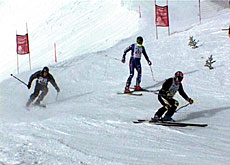Braving skiing’s Inferno

The organisers of the Inferno, the oldest surviving – and most demanding – downhill race in the world, did not rate my chances very highly: they assigned me start number 1,495.
But just finishing the gruelling test of nerve, skill and endurance in Mürren, the very cradle of alpine ski racing, turned out to be a small victory in itself.
Nearly 2,000 people of all ages and fitness levels travelled from around the world to the quaint alpine village on Saturday for the privilege of taking part in the legendary Inferno race.
The course consists of steep and icy slopes, narrow passages, long traverses and uphill sections.
If they can survive that, racers also have to avoid hitting or being hit by other competitors, since scores of skiers are on the course at any one time.
They cross the finish line every few seconds from 9am until late in the afternoon.
The less fit participants look up occasionally as they race down the course to find inspiration in the glistening outlines of the Eiger, Mönch and Jungfrau peaks – and to catch their breath.
Ultimate skiing challenge
The Inferno was founded in 1928 by Sir Arnold Lunn, the father of alpine ski racing, and the race is still considered the ultimate skiing challenge.
At 15 kilometres in length (when conditions allow it to be run in its entirety), it is more than three times longer than the longest World Cup downhill race, the Lauberhorn, held traditionally one week earlier across the valley in Wengen.
When the first internationally recognised alpine ski races were held in Mürren in the early 1930s, Lunn’s eldest son took part and he is still racing today.
At 89 years of age, Peter Lunn (see video), one of the top British skiers of the 1930s, is the oldest competitor in the Inferno.
Oldest competitor
“I’ll certainly do it again next year when I’m 90,” Lunn tells me after he crosses the finish line in just under 26 minutes – a full 19 minutes behind the leaders.
“As long as I beat a certain number of people, I’ll keep doing it.”
Lunn is less out of breath and more coherent than many racers who could be his great-grandchildren.
“When this race was first held they had to climb up the whole way to the start [from 1,500 to 2,970 metres above sea level] with skins on their skis, and the course was not groomed as it is today,” he remembers.
Lunn says his father first put him on skis in 1916, just before his second birthday. That was here in Mürren which was the Lunn family’s winter home.
He may now be short on speed but he is certainly long on experience.
Steep and treacherous
He offered me a few words of wisdom on the eve of the race as we stood above the infamous “Kanonenrohr” section, a steep bottleneck which leads into a treacherously narrow passage.
“Swing out to the right and then go to the left side again, because it’s very steep,” he explained. “So I would take it as wide as you can and then take the Kanonenrohr carefully.”
Lunn admits he is mad to be racing at his age: “We all have our obsessions and my first wife said to me, ‘I’m glad it was skiing with you and not drink or women’.”
Then I watch the last surviving witness to the entire history of alpine racing disappearing slowly but surely down the course.
Awe-inspiring scenery
The Inferno gives people like Lunn the opportunity to carry on competing and amateurs like myself the chance to ski the course where competitive racing began, among some of the most awe-inspiring scenery in the Alps.
My number is finally called about five hours after Lunn and 1,400 other skiers have crossed the finish line.
I’d spent the last 90 minutes waiting in the rotating restaurant on the mountaintop just above the starting gate, watching video highlights of the ski stunts performed here in the 1969 James Bond film “On Her Majesty’s Secret Service”.
But when it comes to the race, my role model is Peter Lunn rather than 007, and I follow the veteran’s advice to finish the race beaten but not battered.
My time of 15.43 is good enough for 1,444th place, while Lunn is pleased to have achieved his goal by not finishing last. He will be back next year.
swissinfo, Dale Bechtel in Mürren
The Inferno event was founded by the father of alpine ski racing, Sir Arnold Lunn, in 1928.
The race starts below the summit of the Schilthorn at 2,970m and normally ends 15 kilometres later in the village of Lauterbrunnen at 796m.
This year’s race was shortened to 9.5km due to insufficient snow cover in the lower section.
The race is limited to 1,800 competitors but the organisers receive requests from more than 2,000 each year.
This year’s winning time was 7:34.26 by the 27-year-old Swiss participant, Marcel Fässler.
The oldest competitor was 89-year-old Peter Lunn, son of Sir Arnold Lunn.

In compliance with the JTI standards
More: SWI swissinfo.ch certified by the Journalism Trust Initiative

You can find an overview of ongoing debates with our journalists here. Please join us!
If you want to start a conversation about a topic raised in this article or want to report factual errors, email us at english@swissinfo.ch.